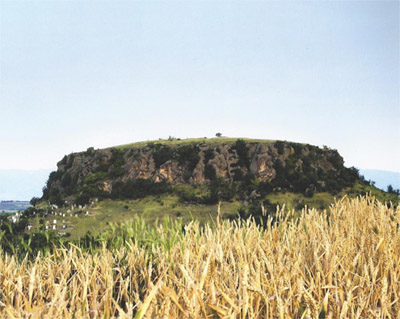Kostoperska Karpa (Žegligovski Kamen)
Kiril Trajkovski
This site overlooks the present-day village of Mlado Nagoričino, 10 km northeast of Kumanovo and the international road which runs towards the east and the city of Kjustendil, Bulgaria. It also represents the remains of the Antique main road Scupi (Skopje) – Serdica (Sofia).
The natural volcanic phenomenon known as Žegligovski Kamen is the crucial point of the Žegligovo region, an area well known in history. It is a basalt cone-shaped rock whose top was used by the population as an ossuary, which inspired the local inhabitants to term it Kostoperska Karpa. In a 500 m diameter area surrounding the rock, remnants of a settlement from the Bronze Age have been discovered, which has been partly destroyed with the building of a modern road.
The west slope of the rock was the burial site of the population during the Roman period, i.e., in the 3rd and 4th centuries AD. The graves contained personal belongings of the deceased which they used in everyday life.
The highest isohypse of the rock was surrounded by a defensive wall that, as a whole, had the features of a small acropolis. Inside it, archaeologists have discovered an Early Christian church from the 6th century in whose vicinity the population buried people belonging to a certain rank.
The underground structures discovered on the south side of the rock remain the most extraordinary and unique structures of their kind on the Balkan Peninsula. They are completely built inside the hill whose geological structure consists of tuff. They have niches and benches used for sitting or sleeping; there is also a staircase which led deeper into the chambers built at a lower level. The air circulated through vertical ventiducts which also served for gathering rainwater in the interior of this extraordinary system of construction and exceptional function. The small entrance led to the interior of the chambers and was closed with a massive stone slab that resembles a millstone. In the space that has only partially been explored, the archaeologists have discovered pottery and glass shards, as well as bones of animals that the inhabitants had cooked. Such a reduced or hermetic model of living is the result of the turbulent times in the Byzantine Empire that was exposed to barbarian incursions; hence, the population sought shelter in the so –called “dead cities.” Almost identical structures, built at the same time, have been discovered in the provinces of Asia Minor, in Cappadocia, in Syria, as well as on the Crimean Peninsula. The structures under the rock of Žegligovski Kamen are, at present, unique on the Balkan Peninsula.
References
B. Georgievski, “Podzemniot objekt kaj Kumanovo”, Lihnid 7, Ohrid 1989, 95-100.
